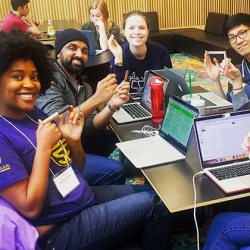Towards Responsible AI: Leveraging Machines that Emulate Human Capabilities

With AI driving rapid change and disruption across industries, businesses and society face opportunity and risk. New mindsets are needed to develop and employ AI responsibly to support positive futures.
Dawn of a New Industrial Revolution
Following mechanization and mass production, the Information Revolution emerged in the 1950s, bringing automation via computers and related information technologies. The magnitude and breadth of today’s rapid technological advancements have far outpaced that of the information age, giving way to what some refer to as a Fourth Industrial Revolution, also known as the 4IR.
In a research collaboration with University of Michigan Professor Lionel Robert and Copenhagen Business School Professor Xiao Xiao, we define the 4IR as the widespread emergence of machines possessing human-like capabilities to discern, decide, create, and collaborate. Chances are you’ve come across some of these human-like capabilities lately, perhaps in the form of a vehicle that makes safety decisions in real-time, or a viral AI-generated video from a single text prompt that is almost indistinguishable from reality. You might have even started utilizing some of these capabilities in your professional life, as more than half of US employees admit to using generative AI on the job.
The problem is that AI and related 4IR tech are viewed from the perspective of the Information Revolution—as mere “tools” that can help us to be more productive. Perhaps we should adopt more expansive framings, as suggested by Microsoft’s AI Chief Mustafa Suleyman, who calls AI a “digital species.” Our research identifies the roots of these narrow framings and suggests a new framing centered on machines that emulate human capabilities.
Gaps in Research
In a study published last year in Information Systems Journal, we examined 48 articles examining the 4IR in the information systems literature, finding that roughly 90% of the articles focus on instrumental outcomes such as productivity, 50% take a predominantly technical or technological imperative approach, and 4IR technologies such as AI are named but rarely examined or described. The role of humans, and the unpacking of what we mean by the term AI, were found to be understudied.
While important, the focus on AI as an abstract technology and its economic impacts neglects the human element. How will teams of humans and machines collaborate in the workplace? What oversight will we need for autonomous teams of machines working together towards a common goal? What happens when things go wrong? What roles are machines best suited for in organizations? Can machines ever be unbiased in their decision-making? How might bad actors employ machines for nefarious purposes? Will machines eventually dumb down humans, and what are the implications for human evolution? Will machines employ ever-larger amounts of energy, exacerbating the climate crisis? These and other questions call for a new conceptualization of AI that enables recentering humans to be central actors within the AI discourse.
Recentering Humans in the Discourse
A new conceptualization of 4IR technologies is imperative to catalyze new research addressing these issues and bring humans back in the loop. Insights from our research indicate that machines can understand their environment (by reading text, looking around inside a warehouse, or hearing sounds produced by birds in a forest) and learn how to appropriately respond (such as by creating an image, moving a pallet, or analyzing data to identify bird population trends). For this reconceptualization, we frame AI and related technologies as machines that emulate human capabilities, identifying four such capabilities:
Machines Emulating Human Cognition:
- Expansive decision-making: Machines capable of either enhancing, aiding, augmenting, or replacing human decision-making.
- Creativity automation: Machines capable of creative capabilities, including generating videos, captioning photos, composing music, writing code, and so forth.
Machines Emulating Human Collaboration:
- Relationships with humans: Machines capable of enabling humans to engage in relationships with them.
- Intermachine teaming: Machines capable of collaborating autonomously to achieve objectives.
Thinking about AI as machines that emulate human capabilities requires a mindset shift. There is no “one” AI technology: there are purposely developed machines that have purposely developed capabilities with diverse bundles of expertise. This mindset can support the thoughtful development of new applications that advance society and mitigate risk. For example, AI safety regulations drafted by governments and other organizations often focus on AI as a decision-making technology. Our more comprehensive set of four capabilities would support a more extensive set of design and deployment regulations.
And for those who say that regulation limits innovation, it may be true. But would we roll back special auto speed limits near elementary schools? Would we remove bans on carcinogens in food production? Would we eliminate laws that limit deceptive advertising of financial products to senior citizens? Without deliberate and careful societal oversight of machine capabilities, our ability to leverage their role in supporting positive futures will be limited.
It is not too late to envision and work toward a better future that leverages increasingly capable machines. The human capability emulation framework may provide one approach that supports such a pathway.








